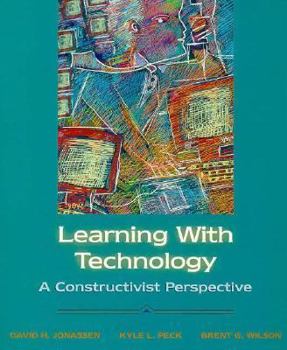Learning with Technology: A Constructivist Perspective
This book addresses how to use very specific types of technology and focuses on how technology can be used as a thinking tool to foster meaningful learning. The book approaches learning from a... This description may be from another edition of this product.
Format:Paperback
Language:English
ISBN:013271891X
ISBN13:9780132718912
Release Date:August 1998
Publisher:Prentice Hall
Length:234 Pages
Weight:0.90 lbs.
Dimensions:0.4" x 7.4" x 9.1"
Related Subjects
Education Education & Reference Instruction Methods Pedagogy Schools & Teaching TextbooksCustomer Reviews
2 ratings
A Constructivist Approach to Learning
Published by Thriftbooks.com User , 22 years ago
Learning with Technology: A Constructivist Perspective analyzes and advocates a different teaching methodology from the traditional teaching methodology. Although the focus of the book is on technology, the authors explain why the constructivist paradigm provides a more effective method for teaching students to think and to learn in all aspects of education. Constructivists contend that knowledge is constructed, emergent, and grounded in action or experience. Constructivism is relatively new to educational analysis; however, it is not new to the theory of knowledge. Teachers in the classroom and academics are the audience for this book. The authors not only argue for a change in the dominant paradigm of traditional teaching methodology, but also provide concrete examples of activities for using constructivism and technology to allow students to construct knowledge, to think and to learn. Constructivist learning emphasizes the five different attributes of meaningful learning which are (i) intentional learning, (ii) active learning, (iii) constructive learning, (iv) cooperative learning, and (v) authentic learning. Real learning requires combining the different elements of meaningful learning. The authors describe six ways to use technology and constructivist learning to allow students to construct understanding and learn. The authors describe the types of technology in very basic terms and the specific hardware and software that are required for the classroom in order to partake in the activities described in the book. For each technology, the authors describe activities and projects that can be used to facilitate learning. They also describe the learning process, the role of the student, the role of the teacher, and ways to assess the learning process. For example, the Internet can be used to allow students to construct complex knowledge bases. The Internet facilitates knowledge exploration by students. Students can find information on the Internet, create and build information through designing web sites, and communicate and share knowledge through the Internet. All five attributes of meaningful learning are employed in the activities described for using the tools of the Internet. Empowering learners to construct knowledge through active learning and the creation of learning communities can be achieved through the use of the Internet as a learning tool. Video is an additional technological tool the authors advocate to support constructivist learning. Under the traditional paradigm, film and videos are merely shown to students in a passive manner. Constructivist learning employs video as an active tool that requires learners to produce information, as opposed to consume information. Learners must be active, constructive, intentional, and cooperative to produce video. Newsrooms, talk shows, documentaries, theatre, and video conferencing are all examples of how students can use video to construct knowledge and communities
Extended essay
Published by Thriftbooks.com User , 22 years ago
This book is a very long essay into how to use computers to help students learn. It begins with a short and very readable explanation of constructivism, one of the first that I've been able to understand. It then goes on to argue for constructivist uses of technology in the classroom, suggesting ways to use technology to do more than drill and practice or even simple training in productivity software. The main technology topics in the book are: video; hypermedia; e-mail, chat, and bulletin boards; and simulations. Many examples of specific software or websites are examined in great detail, with suggestions about possible learning processes, student roles, teacher roles, and assessing learning. References and thought questions are presented after each chapter, and there is an index. Nevertheless, I wouldn't use this as a textbook in an introductory educational technology course where students have limited expertise with technology. I think it might work well, however, if the students are thoroughly familiar with technology and are ready to give careful thought to its role in the classroom.





